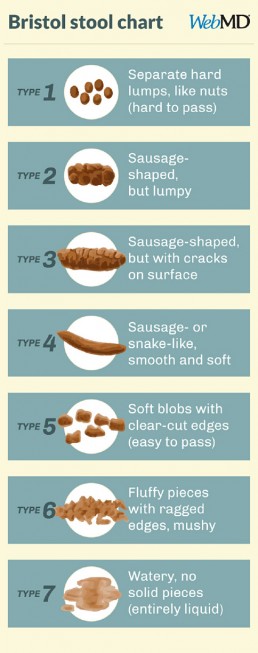People don’t talk about poo. It’s considered ‘bad taste,’ or ‘immature.’ Yet it can be one of the most useful indicators about what is going on in the body – the shape, size, colour and consistency alone can give us lots of clues and a useful tool I use in clinic to get the conversation rolling is the Bristol Stool Chart. Yes, if you come and see me, you can expect me to bring out a laminated sheet displaying different drawings of poo!

Generally speaking, types 3 and 4 are the ‘optimum’ stools, and you’d want to be producing them between 1-3 times most days. They should be easy to pass and painless, and not associated with any immediate urgency – i.e. if you have to wait until you find a loo it wouldn’t be uncomfortable. I say ‘generally’ because we are all different and there might be cases when an individual’s bowel habits don’t conform to the ‘optimum’ but are still perfectly healthy for them.
It’s also quite normal for stools to vary depending on what you’ve been eating most recently or how your lifestyle has been. For instance, have you ever been on holiday and not pooped for several days? Believe it or not, change in routine can really disrupt your loo schedule! Stress, medication, alcohol, indulgent meals, the menstrual cycle and illness can all impact and alter bowel movements but if you’re regularly experiencing constipation or urgency and loose stools, it might be a good idea to talk to someone.
Let’s look at the stool chart in more detail.
Types 1 and 2 are likely to go hand in hand with less frequent trips to the loo, or even with constipation. It might be that you’re dehydrated and need a bit more water – the body will draw water back out from the colon in order to compensate for the dehydration, making stools firmer and harder to pass. It might be that your fibre intake is low – these stools might be expected if you’re following a diet low in carbohydrates. It can even be a sign that you’ve been inactive – exercise can help to get things moving. These stools will have spent longer in the colon than is ideal, allowing for the reabsorption of toxins that should have been eliminated, including excess hormones. This is one reason why addressing bowel movements is a key part of supporting detoxification.
Types 5, 6, and 7 are likely to be more frequent, possibly associated with an urgency to go. It is likely that the stool has spent less time in the colon, therefore leaving less opportunity for food and water to be absorbed which is why these stools are looser, possibly indicating diaorrhea. Since less water is being absorbed, it is important to drink plenty of fluids in order to replenish. These types might also be indicative of a low fibre diet, since the stools are not firm.
Other aspects of appearance such as colour and greasiness, along with smell, are also useful indicators of what else might be going in in the gut. An ‘ideal’ poo (again, we’re speaking generally here) might be a mid-dark brown, wouldn’t leave marks on the toilet bowl and wouldn’t have a strong odour.
If you’d like to find out more about what your bowel movements might mean, please do get in touch and we can discuss how to optimize your digestion. There are even functional tests that can be done where a sample of your stool is sent to a laboratory to find out all sorts of more detailed information such as the composition of the bacteria in the gut, the level of enzymes that help to digest protein, carbohydrate and fats, whether there is any inflammation in the gut and even whether there are any yeast, microbes or parasites present. I’m very happy to break to poo taboo and get talking!
REFERENCES
Blake, M., Raker, J. and Whelan, K. (2016). Validity and reliability of the Bristol Stool Form Scale in healthy adults and patients with diarrhoea-predominant irritable bowel syndrome. Alimentary Pharmacology & Therapeutics, 44(7), pp.693-703.
Chang, Y., El-Zaatari, M. and Kao, J. (2014). Does stress induce bowel dysfunction?. Expert Review of Gastroenterology & Hepatology, 8(6), pp.583-585.
WebMD. (2019). What Kind of Poop Do I Have?. [online] Available at: https://www.webmd.com/digestive-disorders/poop-chart-bristol-stool-scale [Accessed 6 Aug. 2019].
